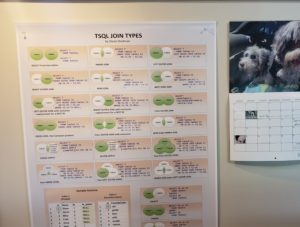As a long-time SQL Server consultant and database administrator, I understand the importance of having a clear understanding of the different join types available in SQL Server. Join types allow us to combine data from two or more tables, and they are essential for creating complex queries and reports.
To help make understanding join types easier, I have created a poster that provides a visual representation of the different join types in SQL Server. The poster is available on my website at stedman.us and can be ordered in a variety of sizes to suit your needs.
The poster includes several different join types: inner join, left outer join, right outer join, cross join and more. Each join type is depicted in a different color, making it easy to distinguish between them. The poster also includes a brief description of each join type, along with an example of how it is used in SQL Server.
The inner join,
is the most commonly used join type and is used to return only the rows that have matching values in both tables. It is useful for queries that require data from two or more tables to be combined, but only when a match is found in both tables. For example, if you have a customer table and an orders table, an inner join can be used to return only the customers who have placed an order.
The left outer join,
is used to return all the rows from the left table and the matching rows from the right table. This join type is useful when you want to include all the data from one table, even if there is no matching data in the other table. For example, if you have a customer table and an orders table, a left outer join can be used to return all the customers, even if they have not yet placed an order.
The right outer join,
is similar to the left outer join, but it returns all the rows from the right table and the matching rows from the left table. This join type is useful when you want to include all the data from one table, even if there is no matching data in the other table. For example, if you have an orders table and a customer table, a right outer join can be used to return all the orders, even if the customer who placed the order has not yet been added to the customer table.
The cross join,
returns the Cartesian product of the two tables, resulting in a combination of every row from both tables. This join type is useful when you want to combine data from two tables in all possible ways. However, it can also result in a large number of rows, so it should be used with caution.
The poster is a great resource for anyone who works with SQL Server and needs to quickly understand the different join types. It is especially useful for those who are just starting out with SQL Server or who are looking to refresh their knowledge of join types.
In addition to the poster, I also offer online training courses and consulting services for SQL Server. I am passionate about helping others improve their skills and understanding of SQL Server, and I have helped numerous individuals and organizations to optimize their database performance and increase productivity.
If you are looking for a handy reference tool for SQL Server join types, I highly recommend checking out my poster on stedman.us. It is available in a variety of sizes, so you can choose the one that best suits your needs. And if you need additional help with SQL Server, please feel free to reach out to me.
Thank you for reading, and I hope you find the poster and my services useful!
More from Stedman Solutions:

Steve and the team at Stedman Solutions are here for all your SQL Server needs.
Contact us today for your free 30 minute consultation..
We are ready to help!

